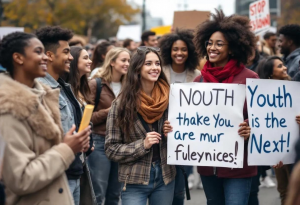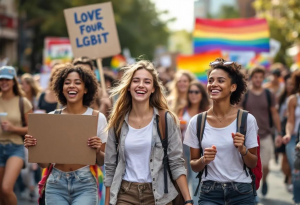
Kumusta, kabataan! (Hello, youth!). I’ve spent years working with young people, and one thing I know for sure is the incredible power of a strong, supportive network. But what happens when that network isn’t open to everyone? That’s the question that keeps me up at night. Building inclusive youth networks isn’t just a feel-good initiative; it’s essential. It’s about making sure every young person, no matter their background, identity, or circumstances, has a voice that matters.
How many times have you been in a meeting where the same voices dominate, while others stay silent? It happens way too often. It’s especially damaging in youth networks, where we should be fostering leadership and empowerment. We need to actively break down the barriers that stop young people from participating and sharing their unique perspectives. It’s not just about inviting them; it’s about listening.
The Inclusion Illusion: Why Aren’t All Youth Networks Truly Open?
Let’s be real: Creating truly inclusive spaces is hard. It forces us to confront our own biases, challenge the status quo, and create real opportunities for marginalized voices to be heard. What are some of the hurdles?
- Lack of awareness: Sometimes, we’re blind to the ways our networks exclude certain groups.
- Systemic barriers: Socioeconomic disparities, language barriers, and plain old discrimination get in the way.
- Tokenism: Inviting a few diverse members just for show? That’s not inclusivity.
- Dominant group culture: When one group’s norms drown out everyone else’s perspectives.
Disturbing numbers: A recent study by the National Youth Rights Association revealed that only 30% of young people feel their voices are actually heard in decisions that affect their lives. We need to do better.

Turning the Tide: Strategies for Real Inclusivity
So, how do we move beyond good intentions? Here’s a guide based on my experiences working with youth organizations in the Philippines and elsewhere:
1. Know Your People: Conduct a Needs Assessment (Alamin ang Kailangan)
Before you jump into anything, you need to understand the specific needs and challenges of the young people you’re trying to reach. This means:
- Data Collection: Surveys, focus groups, interviews – get the stories straight from the source.
- Gap Analysis: Where is your network falling short? Identify the holes.
- Community Listening: Talk to community leaders, parents, and other stakeholders for a wider view.
When I started Kabalikat Para Sa Kabataan, we spent months talking to young people in different barangays (villages) in Cebu. A major roadblock? Many couldn’t afford transportation to our programs. We created a transportation fund to fix that.
2. Build Bridges: Engage Diverse Stakeholders (Makipag-ugnayan sa Iba’t Ibang Grupo)
Inclusivity isn’t a solo mission. You need to actively engage with diverse stakeholders, including:
- Youth from Marginalized Communities: Make sure they’re involved in everything – planning, decision-making, the works.
- Community Organizations: Partner with groups that already have strong ties to diverse communities.
- Educators and Mentors: Recruit teachers, counselors, and mentors to connect young people to your network.
- Policymakers: Advocate for policies that support inclusivity and equity.
Don’t just invite people to the table – create an environment where they feel safe and encouraged to share.
3. Walk the Walk: Implement Inclusive Policies (Magpatupad ng Patakarang Kasama ang Lahat)
Your policies must reflect your commitment to inclusivity. This means:
- Accessibility: Make sure your programs are accessible to everyone, regardless of disabilities or language barriers.
- Language: Offer materials and interpretation in multiple languages.
- Cultural Sensitivity: Be aware of cultural differences and avoid making assumptions.
- Zero Tolerance: No discrimination or harassment, period.
4. Cultivate Empathy: Foster a Culture of Respect and Understanding (Pagyamanin ang Paggalang at Pag-unawa)
Inclusivity is more than just rules; it’s about creating a culture of respect and empathy. Focus on:
- Promoting Dialogue: Create spaces for young people to share their stories.
- Cross-Cultural Understanding: Workshops and activities that celebrate different cultures.
- Challenging Biases: Encourage self-reflection on personal biases.
- Celebrating Diversity: Recognize the unique contributions of each member.
I once organized a youth summit with participants from various ethnic groups in the Philippines. A young Muslim girl shared her experiences with discrimination and Islamophobia. Her story resonated deeply and helped break down stereotypes.
5. Invest in Growth: Provide Training and Support (Magbigay ng Pagsasanay at Suporta)
Building inclusive networks requires ongoing training for everyone involved. Think about:
- Diversity and Inclusion Training: Cover topics like cultural competency, unconscious bias, and allyship.
- Leadership Development: Equip young people from marginalized communities with leadership skills.
- Mentorship Programs: Connect young people with mentors for guidance.
- Mental Health Support: Ensure access to mental health services, especially for those who’ve experienced trauma or discrimination.
Bayanihan (community spirit) is at the heart of Filipino culture. We believe that together, we can achieve anything. That spirit should guide our efforts to build inclusive youth networks.
In Practice: Real-World Examples (Mga Halimbawa sa Totoong Buhay)
These organizations are making inclusivity a reality:
- Global Youth Connect: Connecting young people from around the world to address human rights.
- The Trevor Project: Providing crisis intervention and suicide prevention for LGBTQ youth.
- YouthBuild: Helping young people from low-income communities get education and job training.
They prove that inclusive spaces where all young people can thrive are possible.
Join the Movement: A Call to Action (Panawagan sa Pagkilos)
Building inclusive youth networks is a journey, not a destination. It demands commitment, dedication, and a willingness to learn. Here’s your challenge:
- Assess: Where can your network be more inclusive?
- Plan: Create a plan to implement the strategies we’ve discussed.
- Act: Start small, but start now. Every step counts.
- Share: Inspire others by sharing your successes and lessons learned.
Maraming Salamat! (Thank you very much!). Let’s work together to create a world where all young people can reach their full potential. Kaya natin ito! (We can do this!)

